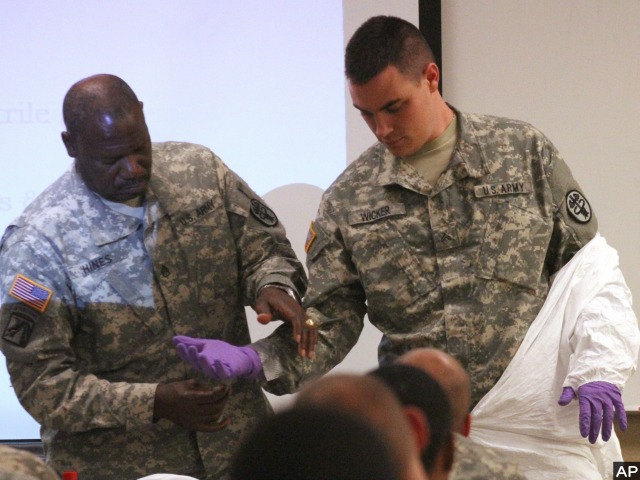Defense Secretary Chuck Hagel has signed an authorization to mobilize an estimated 2,100 Army Reserve and National Guard soldiers from 12 states to fight the lethal Ebola virus in West Africa.
The U.S. Army has identified 16 Reserve and National Guard units from across the country to deploy in the spring of 2015 as part of Operation United Assistance, the official name of the Ebola mission.
“Army officials are in the process of notifying individual soldiers and their families of this mobilization. Once all of the appropriate notifications have been completed, we will provide additional information about units and specialties being mobilized,” Rear Adm. John Kirby, the Pentagon press secretary, said in a statement.
Some units have already been notified about the upcoming deployment.
“These troops will replace forces in Senegal and Liberia who are supporting our whole-of-government response to the most devastating Ebola outbreak in history,” Kirby explained. “All soldiers will conduct regionally-specific training on Ebola prevention, malaria prevention, other medical threats, and medical readiness requirements before deploying.”
The Pentagon has repeatedly stressed, that with the exception of specially trained personnel who will be handling mobile labs containing bodily fluids from Ebola patients, U.S. forces will not be directly exposed to the virus. American soldiers will not be treating Ebola patients, according to the Pentagon.
Last month, President Obama issued an executive order authorizing the involuntary activation of certain Reserve and National Guard troops for Operation United Assistance.
Maj. Gen. Gary Volesky, who has assumed responsibility of the Ebola mission, told Pentagon reporters last week that the U.S. has reduced the number of troops committed to stemming the deadly Ebola outbreak in West Africa from 4,000 to 3,000. There are an estimated 2,200 U.S. troops in Liberia already.
Gen. Volesky is the commander of the storied 101st Airborne Division.
During the press conference, he said no U.S. troops have been infected with the virus.
“These reserve component units were selected based on their capabilities and ability to respond to the unique demands of the mission, and were done in consultation with the Chief, National Guard Bureau, and the Chief, Army Reserve,” said the Army in a statement identifying the Reserve and National Guard units expected to be mobilized in support of Operation United Assistance.
In briefing Pentagon reporters along with Gen. Volesky, Deborah Malac, the U.S. Ambassador to Liberia, said that the rate of Ebola infection cases continues to rise, but at a much slower pace.
Mobilizing Army National Guard units include:
34th Infantry Division Headquarters, Minnesota Army National Guard
16th Engineer Brigade Headquarters, Ohio Army National Guard
223rd Military Intelligence Battalion (Linguist Detachment), California Army National Guard
272nd Engineer Company (Vertical Construction), Texas Army National Guard
294th Area Support Medical Company, Iowa Army National Guard
891st Engineer Battalion, Kansas Army National Guard
Mobilizing United States Army Reserve units include:
96th Sustainment Brigade — Salt Lake City, Utah; and Denver, Colorado
313th Movement Control Battalion — Baltimore, Maryland
324th Fire Fighting Detachment — East Point, Georgia
324th Expeditionary Signal Battalion — Granite City, Illinois
329th Survey and Design Team — Saint Joseph, Minnesota
387th Medical Logistics Company — Miami, Florida
398th Combat Sustainment Support Battalion — Rockville, Maryland
452nd Preventative Medicine Team — Miami, Florida
996th Horizontal Engineer Company — Milwaukee, Wisconsin
B Company, 412th Civil Affairs Battalion — Columbus, Ohio

COMMENTS
Please let us know if you're having issues with commenting.